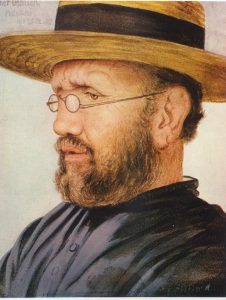But whereunto shall I esteem this generation to be like?
It is like to children sitting in the market place.
Who crying to their companions say:
We have piped to you, and you have not danced:
we have lamented, and you have not mourned.
For John came neither eating nor drinking; and they say: He hath a devil.
The Son of man came eating and drinking, and they say:
Behold a man that is a glutton and a wine drinker, a friend of publicans and sinners.
—Matthew 11:16-19
 There are critics of Mother Teresa,[1] just as there are critics of Pope John Paul II, and there were critics of St Francis de Sales,[2] as there were critics of Father Damien of Molokai.
There are critics of Mother Teresa,[1] just as there are critics of Pope John Paul II, and there were critics of St Francis de Sales,[2] as there were critics of Father Damien of Molokai.
And there were critics of Jesus. Should He really have upended all the moneychangers’ tables and caused chaos in the Holy Temple? What was He doing speaking with Samaritans and women? Who was this upstart carpenter’s son to go around lecturing Pharisees and scribes, and making the sacrilegious claim that He was the altogether transcendent Almighty God? Jesus said to them: Amen, amen I say to you, before Abraham was made, I am (John 8:58).
Father Damien de Veuster gave everything of himself for the lepers of Molokai, suffering great loneliness and sorrow in his final leprous years,[3] just as Mother Teresa endured a terrible dark night of the soul amidst her labors. Father Damien did not mince his words; he employed a sharp tongue on those who interfered with his difficult mission.[4] Likewise, Mother Teresa spoke uncomfortable truths about the dignity of all humans from conception to death, even when they discomfited the president of the United States at the National Prayer Breakfast.[5]
When Father Damien died, the Sydney Presbyterian published scurrilous remarks, calling him “a coarse, dirty, headstrong bigot…not a pure man in his relations with women,” whose leprosy was “due to his vices and carelessness.”[6]
The Presbyterian-turned-atheist writer Robert Louis Stevenson was incensed. He had visited Molokai shortly after Father Damien’s death and found the religious sisters serving the hideously maimed lepers with divine joy. Stevenson was “cynical about popular heroes,” but here he found heaven amidst hell:
To the Reverend Sister Marianne, Matron of the Bishop Home, Kalaupapa.
To see the infinite pity of this place,
The mangled limb, the devastated face,
The innocent sufferers smiling at the rod,
A fool were tempted to deny his God.
He sees, and shrinks; but if he look again,
Lo, beauty springing from the breasts of pain!
He marks the sisters on the painful shores,
And even a fool is silent and adores.
In response to the lies about Father Damien, Stevenson wrote a letter to the Sydney Morning Herald, ending thus: “The man who did what Damien did is my father…and the father of all who love goodness: and he was your father too, if God had given you the grace to see it.”[7]
Stevenson acknowledged that Father Damien was not a perfect man; indeed, none of our saints except Mother Mary was immaculate. When the Church canonizes someone, it is not a declaration of perfection; instead, it is the celebration of a frail human submitting to God’s perfect will and letting Him work wonders through our broken human nature, just as He restores creation through Christ’s incarnation.
The legacies of saints are often imperfect; their followers are also fallible humans, and prone to stumbling along the rocky path to Paradise. But God chooses to bring good out of His messed-up creation, turning pain and sorrow into everlasting joy.
These things I command you, that you love one another.
If the world hates you, know ye, that it hath hated Me before you….
Remember My word that I said to you:
The servant is not greater than his master.
If they have persecuted Me, they will also persecute you:
if they have kept My word, they will keep yours also.
—John 15:17-18,20
The wonder is
Damien clothed himself
in degradation
and announced
the Gospel truth
one radiant June,
from his pulpit;
That Jesus Christ
– Emmanuel –
had visited Molokai
now and forever
as a leper
among lepers.
—Fr William McNichols, “Damien de Veuster”[8]
—
[1] Sr Theresa Aletheia Noble, “5 Responses to the Ridiculous Rancor of Some Toward Mother Teresa”, Aleteia <http://aleteia.org/2016/04/05/5-responses-to-the-ridiculous-reasons-some-atheists-hate-mother-teresa/>.
[2] Douglas Harper, “Saint”, Online Etymology Dictionary <http://etymonline.com/index.php?term=saint>.
[3] Emily Stimpson, “A saint who could never be tamed”, OSV Newsweekly <https://www.osv.com/OSVNewsweekly/Article/TabId/535/ArtMID/13567/ArticleID/4315/New-saint-could-never-be-tamed.aspx>.
[4] Ibid.
[5] Peggy Noonan, “Still, Small Voice”, Catholic Education Resource Center <http://www.catholiceducation.org/en/faith-and-character/faith-and-character/still-small-voice.html>.
[6] Fr F.E. Burns PE, “The Strange Case of Father Damien and Robert Louis Stevenson”, AD2000 Vol 15 No 8 (September 2002), p. 10. <http://www.rememberingkalaupapa.org/kalaupapa-history/the-strange-case-of-father-damien-and-robert-louis-stevenson/>.
[7] Ibid.
[8] <http://puffin.creighton.edu/jesuit/andre/poems/42.html>
Image credit: Edward Clifford, 1868, Honolulu Museum of Art.





